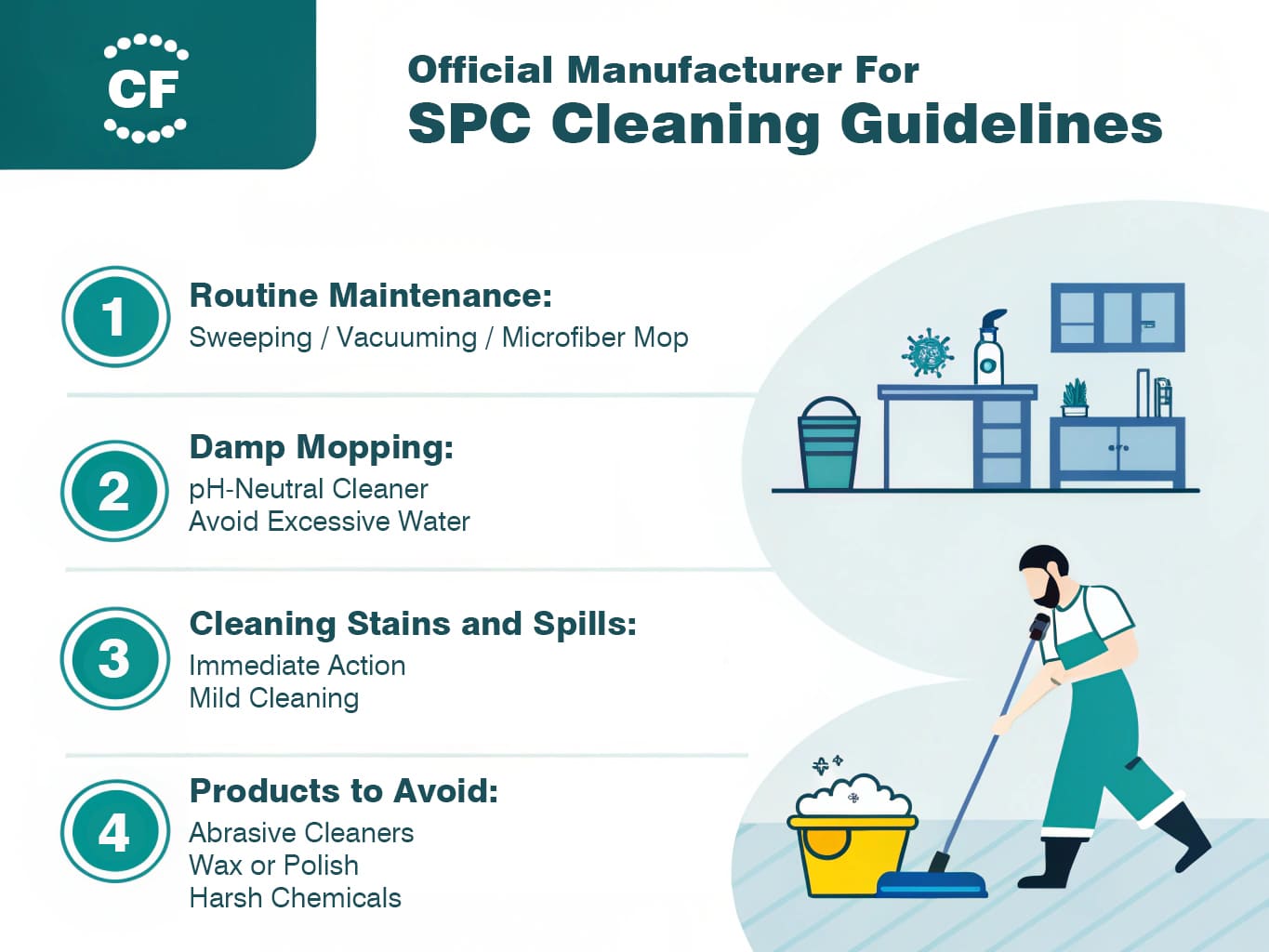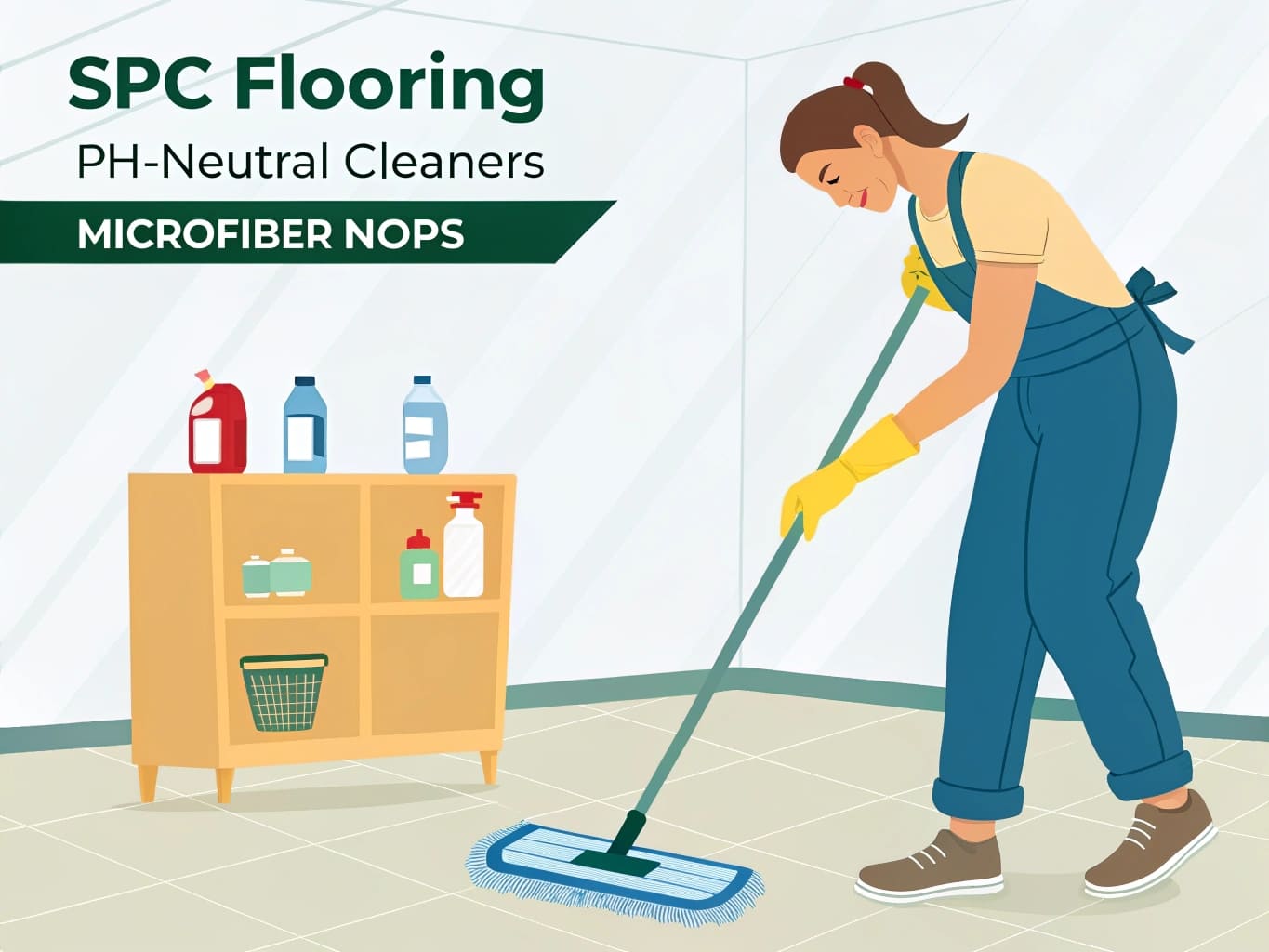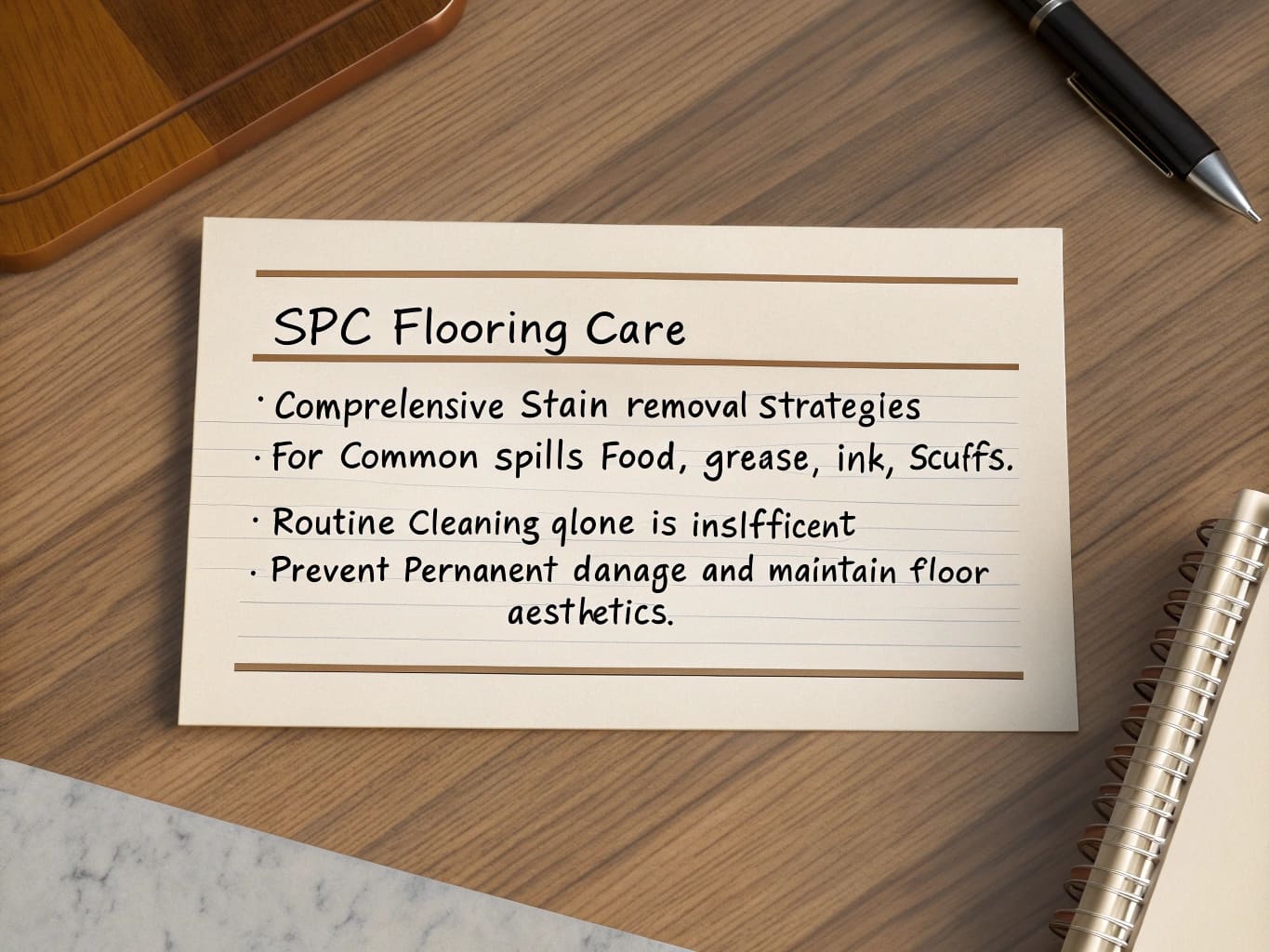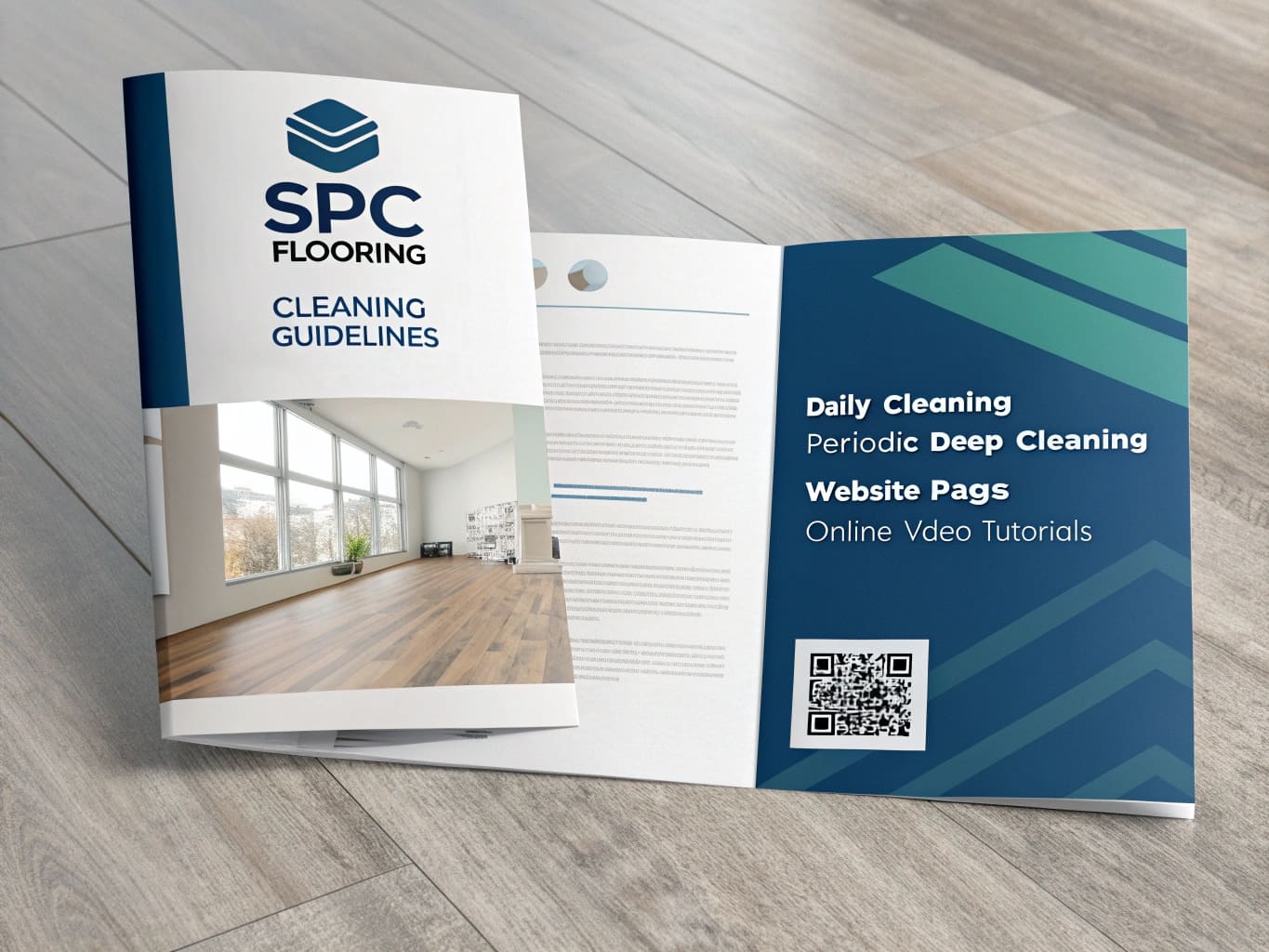SPC flooring is tough, but improper cleaning can damage it. Your customers need clear guidance. I can help you understand what essential cleaning guidelines you should provide.
Official manufacturer guidelines for SPC flooring cleaning should detail routine maintenance, recommended products, specific stain removal methods, and clear dissemination strategies, ensuring product longevity and customer satisfaction for distributors.

When I talk with our partners, like Aiden from the UK, or Lori in the US, I always emphasize that the quality of our SPC flooring from CloudsFlooring is just the beginning. How it’s maintained truly defines customer satisfaction. Clear guidelines are not just about cleaning; they are about protecting your brand and ensuring your clients get the most out of their investment. This is something I’ve learned is key for our B2B partners.
What is the best way to clean SPC flooring?
Customers often guess how to clean SPC flooring. Without clear instructions, they might damage it. Knowing the best method protects your product and reputation.
The best way to clean SPC flooring involves regular sweeping or vacuuming, followed by damp mopping1 with a pH-neutral cleaner2. Avoid harsh chemicals3 and excessive water to maintain its integrity and appearance.

From my experience here at CloudsFlooring, communicating simple, effective cleaning practices is crucial. When we provide our distributors with clear guidelines, it reduces customer complaints and ensures the longevity of the flooring.
Daily Upkeep Essentials
The first step in maintaining SPC flooring is consistent daily care. This means regularly sweeping or vacuuming the floor. You should always use a soft-bristle broom. A vacuum cleaner with a soft brush attachment also works well.
This helps remove loose dirt, dust, and grit. These particles can act like sandpaper underfoot. Grit can cause tiny scratches over time, dulling the floor’s finish. Removing these particles daily prevents surface damage and keeps the flooring looking new. It is a simple habit, but it makes a big difference.
Damp Mopping Best Practices
After sweeping, damp mopping is the next important step. Always use a microfiber mop. Microfiber mops are excellent because they pick up dirt efficiently. They do not require excessive water.
It is vital to wring out the mop thoroughly. It should only be damp, not wet. Too much water can potentially get into seams. Even with SPC’s water resistance, too much water should be avoided.
The most important rule here is to use a pH-neutral cleaner. Harsh, acidic, or alkaline cleaners can strip the finish. They can leave a sticky residue or even discolor the flooring over time. A pH-neutral cleaner cleans effectively without harming the SPC wear layer.
I always tell our partners that regular damp mopping, perhaps weekly or bi-weekly depending on foot traffic, will keep the floors spotless. It will also extend their life. Never use steam mops, abrasive cleaners, or wax and oil-based products on SPC flooring.
| Cleaning Action | Recommended | Avoid |
|---|---|---|
| Sweeping/Vacuuming | Soft-bristle broom, vacuum with soft brush attachment | Vacuum with beater bar |
| Mopping | Microfiber mop, damp (not wet) | Soaked mop, excessive water |
| Cleaners | pH-neutral vinyl floor cleaner | Harsh acids, ammonia, abrasive cleaners, soap-based detergents, wax, oil-based products |
| Tools | Soft cloths, gentle scrubbing pads | Abrasive pads, steel wool, scrub brushes |
| Methods | Regular light cleaning | Steam mopping, flooding the floor |
Should these guidelines specify recommended Vinyl Flooring Cleaner types (e.g., pH neutral) and tools (e.g., microfiber mops)?
Generic cleaning advice often leads to confusion. Your clients need precise recommendations for SPC care. Specifying exact products and tools is vital for optimal results.
Yes, guidelines must specify recommended pH-neutral cleaners and tools like microfiber mops. This prevents damage from harsh chemicals, ensures effective cleaning, and maintains the SPC flooring’s warranty and appearance.

When I speak with large company buyers, particularly those focused on quality, they appreciate detailed instructions. Providing specific recommendations for cleaners and tools shows a commitment to product longevity and customer satisfaction. It also helps them confidently assure their own customers.
The pH-Neutral Advantage
Understanding pH is important for floor care. pH measures how acidic or alkaline a substance is. 7 is neutral. For SPC flooring, a pH-neutral cleaner is essential.
These cleaners do not contain harsh acids or strong bases. These chemicals can degrade the protective wear layer of the vinyl. Strong chemicals can strip the finish. They can leave streaks or even cause discoloration over time.
Using a pH-neutral cleaner ensures the floor’s integrity is preserved. Its original luster is maintained. The product warranty remains valid. From my perspective at CloudsFlooring, recommending a pH-neutral cleaner is about protecting the investment our B2B clients make. It prevents common issues that lead to customer complaints and helps maintain the high quality of the product we supply.
Selecting the Right Tools
Just as crucial as the cleaner type are the cleaning tools. Microfiber mops are ideal for SPC flooring. Their unique fibers effectively trap dirt and absorb moisture. They do this without scratching the surface. They are also gentle enough to prevent damage to the wear layer.
You should avoid abrasive tools. These include scrub brushes, steel wool, or harsh scrubbing pads. These can cause permanent scratches or dull spots on the flooring. Similarly, while vacuum cleaners are good for daily loose dirt removal, they must have soft brush attachments. Using a vacuum with a beater bar can damage the SPC surface.
Providing a clear list of recommended and prohibited tools simplifies the cleaning process for the end-user. It helps ensure the floor is maintained correctly. This ultimately reflects well on the distributor’s product quality.
| Category | Recommended | Avoid |
|---|---|---|
| Cleaners | pH-neutral vinyl cleaners | Harsh acids, ammonia, abrasive cleaners, soap-based detergents |
| Tools | Microfiber mops, soft brooms, vacuum with soft brush attachment | Steam mops, abrasive pads, steel wool, wet mops |
Do the guidelines address specific stain removal for SPC Flooring beyond routine cleaning?
Routine cleaning won’t tackle every stain. Customers face unique messes on their SPC floors. Comprehensive guidelines must include specific stain removal strategies.
Absolutely. Effective SPC flooring guidelines should detail specific stain removal for common spills like food, grease, ink, and scuffs, using appropriate methods to prevent permanent damage and uphold floor aesthetics.

I remember a time when a client called, worried about a tough stain on their newly installed SPC floor. Clear, specific stain removal instructions in our guidelines would have given them immediate confidence. This is especially important for our large company buyers who want to reduce post-sales issues.
Common Stain Scenarios & Solutions
Beyond daily cleaning, specific stains require targeted approaches. For common food and beverage spills, quick action is key. A simple wipe with a damp cloth and a small amount of pH-neutral cleaner is usually enough.
For tougher substances like grease, oil, or tar, mineral spirits or isopropyl alcohol can work wonders. Apply these sparingly to a clean cloth. The important thing is to blot the stain, not rub it. This prevents spreading.
For ink or marker stains, rubbing alcohol1 (isopropyl alcohol) applied to a cloth and blotted gently can often remove the mark. Scuff marks, often from shoes, can typically be removed with a pencil eraser. Or, you can gently rub with a small amount of mineral spirits or rubbing alcohol on a cloth. Always follow up by rinsing the area with a damp cloth to remove any cleaner residue.
The ‘How To’ of Stain Removal
When dealing with any stain, a few golden rules apply. First, always blot the stain; do not rub it. Rubbing can spread the stain or push it deeper into the material. Second, always test any cleaning agent in an inconspicuous area of the flooring first. This ensures the cleaner will not damage or discolor the floor.
Third, always rinse the area thoroughly with a clean, damp cloth after using any cleaning agent. This removes any residue that could attract dirt or damage the floor over time. Prompt action is also crucial. The faster a stain is addressed, the easier it is to remove. Never use abrasive materials or harsh chemicals on stains, as these can permanently damage the SPC wear layer. These precise instructions are vital for our B2B partners to pass on, ensuring their customers maintain the flooring’s pristine condition.
| Stain Type | Recommended Cleaner | Method |
|---|---|---|
| Food & Beverage | pH-neutral cleaner, warm water | Blot immediately with clean cloth. Wipe gently. Rinse. |
| Grease, Oil, Tar | Mineral spirits, isopropyl alcohol | Apply to clean cloth. Blot gently. Rinse thoroughly. |
| Ink, Marker, Crayon | Isopropyl alcohol (rubbing alcohol) | Apply to clean cloth. Blot gently. Rinse thoroughly. |
| Scuff Marks | Pencil eraser, mineral spirits on cloth | Erase or gently rub. Wipe clean. Rinse. |
| Lipstick, Nail Polish | Acetone (nail polish remover, non-oily type) | Apply to clean cloth. Blot carefully. Rinse thoroughly. |
| Gum | Ice cube (to harden), dull scraper | Harden with ice. Gently scrape. Clean residue with mineral spirits. Rinse. |
How can distributors effectively disseminate these SPC Flooring cleaning guidelines to retailers and end-users?
Excellent guidelines are useless if unseen. Your crucial cleaning information needs to reach everyone. Effective dissemination ensures your guidelines are used and valued.
Distributors can disseminate SPC flooring cleaning guidelines through printable brochures, QR codes on packaging, website resources, and online video tutorials, ensuring accessible information for retailers and end-users.

Effective communication of guidelines is just as important as the guidelines themselves. As Jessica from CloudsFlooring, I believe in empowering our partners like Lori in the US and Aiden in the UK with the tools to support their customers. This ultimately enhances their brand reputation.
Multi-Platform Approach
To ensure cleaning guidelines reach everyone, distributors should use a multi-platform approach. Digital formats are highly effective. This includes providing downloadable PDF versions of the guidelines on the distributor’s website.
Create a dedicated FAQ section with cleaning tips. Also, include links to these resources in email confirmations after purchase. For physical formats, printing concise cleaning inserts to include in product packaging is very helpful. Many customers prefer a tangible guide they can keep.
Additionally, have point-of-sale materials available at retail locations. These can be small cards or brochures. This ensures that customers receive information right when they purchase. From my observation, the most impactful method is often placing QR codes directly on the product packaging. When scanned, these QR codes can instantly direct end-users to the detailed cleaning instructions on a website. This makes the information easily accessible at any time.
Educational Resources
Beyond just providing static documents, creating educational resources significantly boosts the effectiveness of guideline dissemination. Short, clear video tutorials demonstrating proper cleaning steps are incredibly powerful. Visuals make complex instructions easy to understand and follow. These videos can be hosted on a website or YouTube channel and linked via QR codes.
Another strategy is to offer webinars or training sessions for retailer sales staff. From my experience, when sales teams are well-informed, they can confidently answer customer questions. They can also proactively provide cleaning advice. This kind of knowledge transfer builds trust with the end-user. Utilizing social media, particularly platforms like LinkedIn for our B2B partners, to share quick tips or infographics about SPC flooring care can also reach a broad audience. This reinforces the importance of proper maintenance. This comprehensive approach ensures that the cleaning information is not only available but also easily understood and applied by all end-users.
| Method | Benefit | Target Audience |
|---|---|---|
| Printed Brochures/Inserts | Tangible, always accessible at point of sale | End-users, Retailers |
| Website Resources (PDFs, FAQs) | Easily updated, searchable, comprehensive | Retailers, End-users |
| Video Tutorials | Visual, easy to follow, engaging | End-users, Retailer staff |
| QR Codes on Packaging | Instant access, convenient, digital bridge | End-users |
| Webinars/Training Sessions | In-depth knowledge transfer, builds confidence | Retailer sales staff |
| Social Media Posts | Wide reach, quick tips, brand reinforcement | Retailers, End-users |
Conclusion
Providing clear, comprehensive SPC flooring cleaning guidelines is essential for distributors. It protects your product, satisfies customers, and strengthens your brand reputation.
The above data is for reference only.
-
Find out how rubbing alcohol can effectively tackle tough stains on SPC flooring without causing damage, ensuring your floors stay pristine. ↩ ↩
-
Exploring this link will help you find the most effective pH-neutral cleaners that won’t damage your SPC flooring. ↩
-
Understanding the impact of harsh chemicals will help you avoid damaging your flooring and maintain its appearance. ↩
